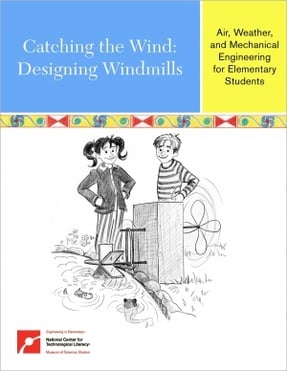 |
| Burke Swenson (r) in his Iowa STEM lab. |
When Iowa STEM instructor Burke Swenson breaks out the Engineering is Elementary unit Catching the Wind: Designing Windmills, he has no trouble making connections between the engineering design challenge his middle school students are about to tackle and their real-life experiences. “The state of Iowa has more wind turbines per capita than anywhere else,” he says. “Go down the interstate an hour, and you’re at a wind farm.”
Kits Make It Easy to Teach Engineering
Swenson first heard about EiE three years ago, shortly after Iowa selected the curriculum for its statewide “STEM Scale-up” program. “We wanted to develop a STEM program for our school (Lewis Central Middle School), and our STEM hub manager suggested the EiE kits,” Swenson says. “As she was rattling off the topics, she said ‘wind turbines,’ and I said, ‘That is perfect for Iowa.’ So she sent me the kit, and I dove right in.”
 |
| Many Iowa community colleges offer courses like this! |
At the time Swenson was making a transition—from the school technology coordinator to a new role, STEM instructor. He says the EiE Teacher Guides made his transition an easy one. “Those manuals—they’re so step-by-step and explain things so well,” he says. “If you can’t find the answer to what you are looking for, you must be reading it upside down!”
EiE in Middle School? Yes!
 |
| The EiE “Windmills” unit introduces students to mechanical engineering. |
Although EiE was designed for elementary students, Swenson finds the units easy to adapt for middle school. “Our hub manager said you can make these kits as simple or as complex as you want, and that’s definitely true,” he says. Instead of having kids read the EiE storybook, Swenson picks videos and readings to introduce the different fields of engineering in each unit. “For Windmills, we use some great videos that show the actual construction of wind turbines,” he says.
READ MORE ABOUT ADAPTING EIE FOR MIDDLE SCHOOL
To further scale up this design challenge for 8th graders, Swenson had them consider not just the shape of the blades for the windmill (as the unit prescribes), but also the number of blades and the angle of the blades. “We also studied existing wind turbines to explore the question: ‘Why are three blades the most common design?” he says. The students got very serious about researching their designs to make their windmills as powerful as possible!”
SEE IT IN ACTION: WATCH AN EiE WINDMILLS VIDEO
The More Engineering, the Better
In most grades, teachers work through one to three EiE units over the course of a school year. Swenson was so excited by the range of different engineering challenges and how they integrated with his goals for STEM teaching, he taught nine different EiE units his first year. “How could you not?” he laughs. He borrowed the EiE Teacher Guides from his regional STEM Hub and bought the materials needed for the engineering activities from the local WalMart and Hobby Lobby.
Kids are as excited about the hands-on engineering classes as Swenson is. Though STEM classes are optional, more and more students have opted in, and now almost all of the 750 6th – 8th graders at the school pass through Swenson’s STEM lab each year. “They had to put a cap on it—only two trimesters for sixth graders, to give as many kids as possible the chance to experience STEM,” he says.
Dedicated STEM Lab Makes It Happen
Luckily, the school has a dedicated STEM lab—the former “Family and Consumer Science” room. “It’s a gigantic room, partially carpeted and partially tiled, with student seating, separate work tables and whiteboards, but also countertops and three sinks for cleanup!” Swenson says. “So I can have groups doing research, while other groups are putting their designs together, while other groups are doing an experiment. It’s the best classroom I’ve ever had in 20+ years of teaching!”
Swenson started out teaching the same EiE units in all three grades, but is now starting to earmark units, for example Windmills for sixth grade and Oil Spills for seventh grade. “That way kids can take the class over and over again and always take something new,” he says. Iowa recently adopted the Next Generation Science Standards, and Swenson says it’s easy to map EiE to the standards for each grade.
Engaging ALL Students with Engineering
EiE is intentionally designed to support learning for all students, and Swenson has seen this in action. “For example, when we did the Bridges unit this year,” he says, “one activity calls for students to design a beam bridge using just notecards, and most kids either fold them or roll them to create support beams.” One student came up with the idea of pinning three notecards together into a star shape, with the cards bending in toward the middle. “It was incredibly strong and wide and provided great support,” he says. “All the little circular columns tended to fail at a certain point, but this design held up really well the entire way through!”
“The awesome thing was, I would never have guessed this particular student would conceive this,” Swenson continues. “He didn’t have an overly high attention level, and research wasn’t his forte. But he was really engaged when we were at the tables building. When I told him, ‘You have a knack for this engineering stuff,’ I got a great big, beaming smile. He took my class again this year.”
Earning the STEM Seal of Approval
 |
| Lewis Central went from “No STEM” to “Exemplary STEM” in just three years. |
Three years ago, Lewis Central Middle School was just starting to develop a STEM program; in 2015, the school received at ‘STEM Seal of Approval’ from the Iowa Governor’s Council. Swenson doesn’t have to borrow kits anymore; his school has purchased them. “I plan to use them till I retire,” he says.
Reflecting back to his first experience with the Windmills unit, Swenson says, “I think our students know far more than the average middle school student about wind turbines, and it’s all because of EiE.” And this year, he hopes to try something new: inviting a class speaker to class, a representative from the local community college, which has a two-year program for wind-turbine technicians. “I tell them, after you graduate, in just two years, you could be out and working in a career with wind turbines!” he says. “How’s that for a real-world connection?”
Share YOUR EiE story! If we use it on the blog, we’ll say “thanks!” with a gift of the EiE Teacher Guide of your choice.
Engineering is Elementary is a project of the National Center for Technological Literacy® at the Museum of Science, Boston.









